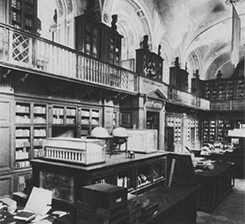ALL ISSUES

CREDITS / TABLE OF CONTENTS, p. 2–3
ARTICLES
Who is the Viellator on Folio 18r of the Sankt Florian Psalter? A Miniature From a Manuscript in the Collections of the National Library of Poland as Seen Through the Medieval Imagination, p. 6–51
The article presents a possible interpretation spectrum of the miniatures, especially that of the fiddler (viellator), that appear on folio 18r of the Florian Psalter, containing the text of Psalm 14(13) (Dixit insipiens...). The methodology applied involves recognizing the roots of cultural sources of the motif. In the case of the fiddler miniature, these are i.a. changes in medieval musical culture, its conceptualization by the theologians of the time, representations of fiddlers in book illuminations, as well as iconographic and exegetical tradition of Psalm 14(13). In the context of the debate about the iconography of this work the article attempts to interpret it based on considering possible meanings of the visual material in relation to the text it accompanies.
KEYWORDS: Sankt Florian Psalter, book illumination, musical iconography, fiddler, viellator, medieval theologyNew Research Perspectives on Franciszka and Stefan Themerson’s Oeuvre. The Case of Film Output, p. 52–75
The artistic achievements of Franciszka and Stefan Themerson are becoming increasingly popular as a research subject in Poland. Although their oeuvre has inspired an extensive academic literature, the Themersons’ work have not been studied in depth and many research topics connected with them have not been investigated at all. This is partly due to the couple’s wide variety of interests and extensive artistic output, and partly because the major part of their archive remained in the United Kingdom until the end of 2014. In this paper we examine the new research perspectives, especially those connected with the Themersons’ film output, which have opened up with the relocation of their archive to Poland.
KEYWORDS: Franciszka Themerson, Stefan Themerson, Themerson Archive, National Library of Poland, manuscripts, film studies, film outputGenre Theory Applied: Genre and Form Terms in the Catalogue of the National Library of Poland, p. 76–98
This paper considers the possible uses of genre and form terms in a library catalogue on the basis of a new solution introduced by the National Library of Poland in January 2017. It begins with a brief look at the modern use of genre and form terms in catalogues, some definitional problems and some reasons behind the need for genre access in libraries. Against this background, the author presents the previous model of genre/form access in place in the National Library of Poland, where genre/form terms were only used to a limited extent. The author then introduces the new model, which has a number of distinct features: genre terms are applied not only to publications about genres but also to publications belonging to specific genres; designations of cultural area and of intended audience are separated from genre terms; and some of the genre terms (“major forms”) are separated from others and combined with form/physical characteristic terms. Certain elements of the new “Form and type” facet are then compared to the FRBR model. Finally, the author considers practical aspects of the new system: “universal” genres which can be combined with more than one genre/form, problems with creating new genre terms, and the relationship between genres and subjects in literary fiction.
KEYWORDS: genre, form, physical characteristics, major forms, faceted search, bibliographic record, subject heading, descriptorsZbigniew Seifert’s Collection in the Polish Jazz Archive, p. 99–114
Zbigniew Seifert was one of the most eminent jazz violinists in history and one of the first Polish jazzmen to achieve success in the United States. Seifert learnt to play the violin in Cracow. Owing to John Coltrane’s music he discovered jazz and become interested in the alto saxophone. “In 1968 and 1969” together with his quartet he won several prizes at the Jazz on the Oder Fes tival. He co-operated with Tomasz Stanko, in whose band he played both the saxophone and the violin. In the 1970s Seifert gave more and more concerts in Western countries, where he gained recognition and career opportunities. He recorded with Joachim Kühn, Charlie Mariano and the Oregon music group. He managed to release two albums in the US, but his further career was stopped by severe illness and death in 1979. Seifert’s collection, donated to the Polish Jazz Archive, National Library of Poland, comprises different types of materials. Most of them are biographical sources documenting Seifert’s life and career, i. a. his school reports and papers dating back to his studies at the Academy of Music (PWSM). An interesting part of it is Seifert’s correspondence with musicians, activists and institutions he worked with, as well as letters to his family. The collection also contains musical scores by Seifert, albeit mainly drafts and working notes, together with a considerable number of photographs and clippings from Polish and foreign newspapers, presenting different fields of Seifert’s musical activity.
Not only is Zbigniew Seifert’s archive an interesting testimony to the life of the great musician, but it also shows certain aspects of how the jazz environment behind the Iron Curtain worked.
KEYWORDS: Zbigniew Seifert, Polish Jazz Archive, violin, jazzFameux Amateur Baron Philipp von Stosch and the Unknown Provenance of Lost Old-Masters’ Drawings From the Collection of Count Stanisław Kostka Potocki, p. 115–163
The article discusses the unknown provenance of old-masters drawings from the collection of count Stanisław Kostka Potocki. The latest archival research carried out at the Department of Iconography, National Library of Poland, followed by work on the catalogue of the graphic-art collection of the Wilanów Library, have shown that valuable drawings, originally belonging to Philipp von Stosch’s collection, were purchased by Potocki. Baron von Stosch is among the great European personalities of the first half of the 18th century, and deserves special attention, all the more that he remains almost completely unknown in Poland. The author presents the biography of Philipp von Stosch and the history of his collection. The small part of the baron’s collection is to be found also in Poland, thanks to Stanisław Kostka Potocki and his passion for collecting art. The author attempts at describing the history of acquisitions made by the count and determines which way the drawings got into his hands. The most important part of the article is the catalogue of 26 drawings, including works by Raphael, Michelangelo, Correggio, Parmigianino, Annibale and Lodovico Carracci, Titian, Rubens and others. On the basis of archival sources the catalogue describes these resources for the first time and as precisely as possible. Just one of those drawings has barely survived, perhaps as irrefutable proof that the others also did exist although they have been lost for almost two centuries. Even taking into account some doubts as to the attribution of the works, their descriptions can be an important source of information about the aspirations of the count as a collector, as well as about the original shape of his collections.
KEYWORDS: Stanisław Kostka Potocki, Philipp von Stosch, old-masters’ drawings, provenance, Raphael, Michelangelo, Correggio, Parmigianino, Annibale Carracci, Lodovico Carracci, Titian, Rubens,
catalogue

